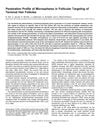TLDR Nanoparticles don't penetrate intact skin but can enter through pores or damaged skin.
The study aimed to evaluate the skin permeation and penetration of nanomaterials, using Fluoresbrite® as a model fluorescent nanoparticle. It was found that Fluoresbrite® only permeated through needle-punctured skin, not intact skin, while soluble high molecular compounds like FITC-dextrans could permeate the skin. The study also observed the distribution of titanium dioxide and zinc oxide nanoparticles from commercial cosmetics, noting that these nanoparticles were distributed into grooves and hair follicles but did not migrate to the viable epidermis and dermis. The results suggested that nanoparticles did not permeate intact skin but could permeate skin with created pores, with little to no permeation through the stratum corneum.
323 citations
,
April 2006 in “The journal of investigative dermatology/Journal of investigative dermatology” Only 40 nm nanoparticles can enter skin cells effectively for potential vaccine delivery.
 316 citations
,
June 2004 in “The journal of investigative dermatology/Journal of investigative dermatology”
316 citations
,
June 2004 in “The journal of investigative dermatology/Journal of investigative dermatology” Microspheres about 1.5 micrometers in size can best penetrate hair follicles, potentially reaching important stem cells.
 3 citations
,
January 2022 in “Pharmaceutics”
3 citations
,
January 2022 in “Pharmaceutics” Nanostructured delivery systems could potentially improve hair loss treatment by targeting drugs to hair follicles, reducing side effects and dosage, but the best size, charge, and materials for these systems need further investigation.
 94 citations
,
September 2014 in “Therapeutic Delivery”
94 citations
,
September 2014 in “Therapeutic Delivery” Nanoparticles can improve skin treatments by better targeting hair follicles, but more research is needed for advancement.
79 citations
,
December 2017 in “Cosmetics” Effective sunscreen formulations can reduce skin absorption and enhance protection.
 12 citations
,
July 2020 in “International Journal of Pharmaceutics”
12 citations
,
July 2020 in “International Journal of Pharmaceutics” Iron oxide nanoparticles improve skin penetration and drug release for hair loss treatment.
14 citations
,
November 2019 in “Materials” Diamond nanoparticles can penetrate skin and reach hair follicles, useful for imaging applications.




